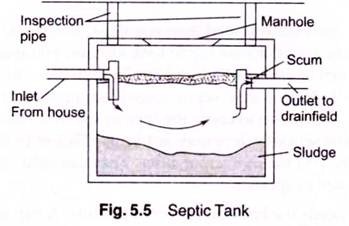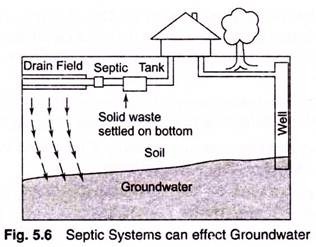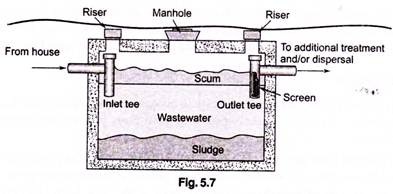In this article we will discuss about:- 1. Introduction to Septic Tanks 2. Functions of Septic Tank 3. Installation 4. Cleaning 5. Disposal 6. Treatment.
Introduction to Septic Tanks:
For homeowners in rural areas (or places with no connection to main sewage pipes), septic tanks are the principal means of waste water disposal. If you are planning to move to a more rural setting, probably for retirement, of course, you will need to have a septic tank system.
The first known installation of a septic tank in the United States was in 1876, although Louis Mouras of Vesoul, France, was given a patent in 1881 and credited with the invention. Baffles, which regulate the flow, were added in 1905 to make the septic tank more efficient. The first baffles were made of oak boards.
At the turn of the century, there were some very large community septic tanks. In 1903, four community tanks were constructed in Saratoga, New York, with a total capacity of one million gallons.
By 1920, septic tanks began to be a common feature. After World War II, septic tanks became important to housing developments in unanswered areas.
There is nothing really complex about how a septic tank works. But, mind you, for all its simplicity, it is very efficient at what it does. The tank can be anywhere from 1000 gallons or higher and thus can accommodate large amounts of wastes. In a nutshell, septic tanks separate solid waste from liquids. The solid waste is stored in the septic tank and treated by anaerobic bacteria. The liquids, on the other hand, are dispersed throughout the soil on the property by the leaching, a mechanism which is a part of the septic tank.
The use of septic tanks may not sound sanitary but there is really nothing to worry about how they treat wastes. Well, septic tanks have been in use for many years all over the country. Nearly 25% of all homes in the country use septic tank systems.
Functions of Septic Tank:
Sewage or untreated household waste will quickly clog all but the most porous gravel formations. The septic tank conditions sewage to allow percolation of the liquid portion into the subsoil. The most important function of septic tanks is to protect the absorption ability of the subsoil. In doing this the septic tank does the following three things.
a. Removes solids from liquid:
As sewage enters the tank, the rate of flow is reduced and heavy solids settle, forming sludge. Grease and other light solids rise to the surface, forming a scum. The sludge and scum are retained and breakdown while the clarified effluent (liquid) is discharged to the drainfield for soil absorption.
b. Provides biological treatment:
Natural processes break down the solids and liquids by bacterial action. The breakdown occurs in the absence of oxygen (anaerobic conditions). The anaerobic conditions are referred to as “septic,” giving the tank its name.
c. Stores scum and sludge:
The solids accumulate in the bottom of the tank to form sludge. The scum is a partially submerged mat of floating solids and grease. Scum and sludge are digested over time and compacted into a small volume. Areas with warm climates, such as the southern United States, allow more complete breakdown of solids 4nd scum than in the cooler climates of the North.
For this reason, tanks in warm climates do not usually need to be pumped or cleaned out nearly as often as those in cold climates. Regardless of climate, a non-volatile residue of material remains in the tank. Sufficient volume for the solids must be provided in the tank between pumpings or cleanings. If the solids fill the tank and enter the drainfield, the solids can clog the soil in the drainfield.
Grease from the kitchen is detrimental to septic tank functions. Effluent from grease traps must go through septic tanks before being discharged to drainfields to prevent soil plugging. The best approach is to put kitchen grease in old milk jugs and place in the garbage rather than into the drain. Small amounts of kitchen grease can go into the septic tank without damaging the system.
Installation of Septic Tank:
Septic tank installation is more complicated than you think. Yes, septic tank installation is a rocket science affair. If you wish to install a new septic tank system, you must check on your property before calling for professional assistance. Does it have enough room for a septic tank? They do not do the measuring, you do it.
Putting up a septic system requires you to know about water tables and soil types as well. It is imperative to know the type of soil that your property carries. Depending on the soil condition, the septic system may not be as efficient in treating waste water. If you have questions, enlist the help of the municipal office. They can help you with measuring your lot and identifying your lot’s soil properties.
Septic tank installation needs the backing power of permits. A trip to the local municipal office needs to be made to be able to start with the actual installation.
If you want to save on your septic tank installation, you have to go through a lot of deciding. This is another thing that makes septic tank installation a rocket science process. Given the many options, it is really hard to pick the right septic tank installation company. Your best bet is to choose the one that offer rates that are fair enough and who you feel can work your instructions best. Think that you can do the installation yourself? Septic tank installation is not a do-it-yourself affair. It can only be done by people with experience.
Cleaning of Septic Tank:
The thing with septic tanks is, when something in them goes wrong, it can be a costly and messy affair. When it comes to septic tank maintenance, “prevention is better than cure”. People with septic tanks need to properly maintain their tanks in order to avoid spending too much money for repair or treatment. Regular septic tank cleaning is the only way to prevent septic tank systems from clogging and well, causing too much financial troubles. Always remember that the more you do to keep your tank in good order, the more years it will keep working great.
So, how do you clean septic tanks? There is really only one way to clean septic tanks and that is by pumping them. Septic tank cleaning through pumping removes the solid build up which is an inevitable part of the septic process. Most septic tank system experts recommend that a typical home with a 1,000-gallon tank should be pumped every three to five years. A smaller tank, of course, needs to be pumped more often.
Septic tank maintenance is not rocket science; it is just all about you understanding the importance of regular septic tank cleaning. If your home uses a septic tank, it is your responsibility to properly maintain that tank. Failing to provide regular treatment and cleaning to your tank, will only give you a whole new set of issues to mind. Replacing “dead” septic tanks can be really costly, so being particular about septic tank cleaning is to your advantage.
Disposal in Septic Tank:
The toilet is not a garbage bin. Flushing cat litter, tissue, sanitary napkins, among others in the toilet will only double the amount of solids added to your septic tank. Garbage disposal, needless to say, leads to a more rapid buildup of sludge layers in the septic tank and increases the risk of clogging. You pay for septic tank cleaning and septic tank additives to prevent your septic tank from clogging. By carelessly flushing random junk in the toilet, you are countering your personal measures. In other words, you are putting your efforts to waste.
Not every from of septic tank disposal is bad, however. In some cases, it can be an advantage to helping your tank function efficiently. Dumping liquefied waste food with added enzymes, for instance can help with keeping the natural process inside the septic tank alive. By grinding waste into fine particles, septic garbage disposal devices bring down additional helpful enzymes into the waste stream and somehow help septic tanks function more efficiently.
But is it really safe to dump “unfit” waste in the septic tank? According to a lot of experts, no. If you really want a healthy septic tank, avoid septic tank garbage disposal totally. Septic tank garbage disposal devices still discharge untreated solids into the tank, which then reduces the efficiency of the tank. Reduced tank efficiency means it failing and you spending big for repairs.
Treatment of Septic Tank:
It is easy to keep your septic system running clean. In order to prevent solid waste from backing up into your septic tank, aside from regularly pumping your tank, it is a clear incentive to employ septic tank treatment.
Septic tank treatment is an easy way to maintain your septic tank. The process involves the use of septic tank additives. As said, when it comes to septic tank maintenance, prevention is better than cure. The use of such chemicals will prevent your septic tank from clogging—the biggest problem concerning septic tanks.
Septic tank treatment makes for a simple and cost effective way to ensure that your solid waste is being dealt with effectively. It will ensure that you have an ample amount of bacteria and enzymes in your septic tank that are necessary in keeping the system free from clog. Septic system replacement is very expensive. Adding septic tank additives is a way of guaranteeing that there are always plenty of active bacteria in your tank.
Employing septic tank treatment by using septic tank additives, although can be costly, is the only way to ensure that you will always have your tank working efficiently. By reintroducing new batches of bacteria and enzymes to your tank, you can be sure that your solid waste is always being broken down and will not back up.


